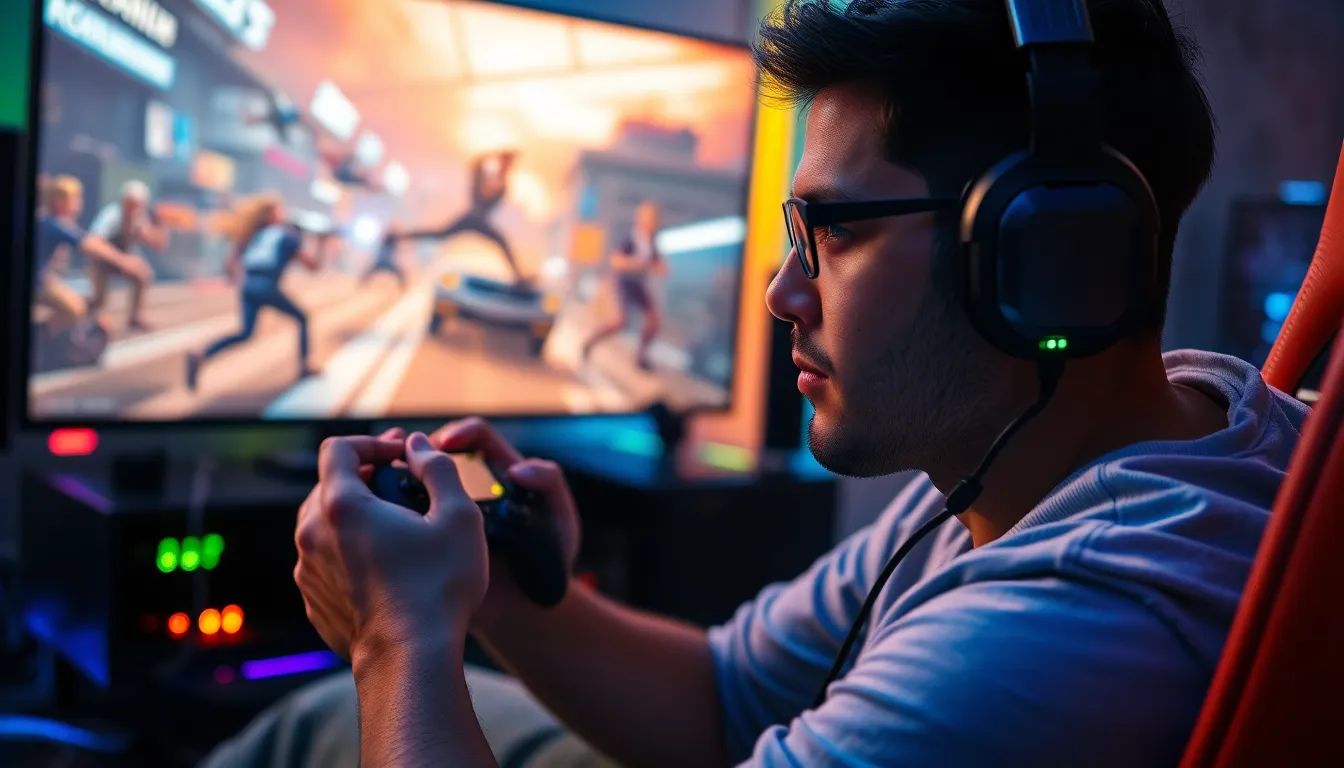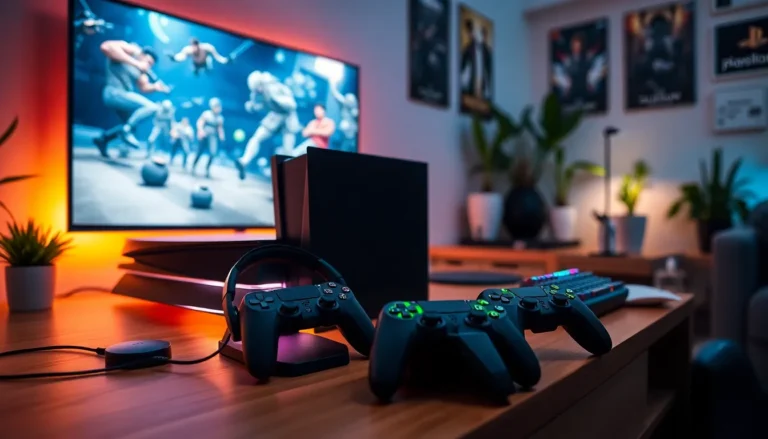In a world where touchscreens reign supreme, haptic feedback quality is the unsung hero of user experience. Imagine playing your favorite game and feeling every explosion and gunfire as if you were right in the middle of the action. It’s like having a personal cheerleader for your fingertips, giving you a high-five every time you score a point.
Table of Contents
ToggleOverview of Haptic Feedback Quality
Haptic feedback quality plays a crucial role in user experience, especially in gaming environments. High-quality haptic feedback enhances immersion, making interactions feel realistic. Various factors contribute to this quality, including device design and actuator technology.
Devices equipped with advanced actuators provide precise feedback, allowing players to feel distinct sensations. Robust feedback can simulate environmental factors, like terrain changes or weapon recoil. Those sensations contribute to the overall experience, improving engagement levels.
Communication between software and hardware also significantly influences feedback quality. Software algorithms determine how feedback manifests, translating actions into tactile sensations. Effective synchronization between these elements creates a seamless experience for users.
Furthermore, game developers utilize feedback design to enhance gameplay. Tailored feedback can vary based on in-game events, enriching user interaction. A well-implemented feedback system lets players respond more intuitively to game dynamics.
Research shows that user comprehension of sensations impacts their engagement. Specific responses like tactile vibrations during critical moments can modify gameplay perception. By prioritizing haptic feedback quality, developers enhance both satisfaction and performance.
Ultimately, the evolution of haptic technology leads to improved user experiences. Ongoing advancements in actuation and feedback design can redefine gaming interactions. Players benefit from richer, more immersive sensations, solidifying the need for continued innovation in haptic feedback quality.
Importance of Haptic Feedback Quality

Haptic feedback quality significantly enhances overall user satisfaction. High-quality feedback plays a vital role in shaping immersive experiences, particularly in gaming.
User Experience Enhancement
User experience often improves due to well-designed haptic feedback systems. Players feel more connected to in-game actions with precise vibrations. Sensations like explosions, impacts, and environmental changes stimulate user engagement. Gamers respond more intuitively as feedback quality increases. Enhanced realism leads to deeper player immersion, making gameplay more enjoyable. Overall, effective haptic feedback creates a more interactive atmosphere, elevating enjoyment and satisfaction levels among users.
Applications in Various Industries
Haptic feedback quality extends beyond gaming into different sectors. For instance, healthcare professionals use haptic technology in training simulators to mimic real-life sensations. Automotive industries employ haptic feedback in steering wheels to alert drivers about potential hazards. Mobile device manufacturers incorporate advanced haptic systems to enhance touch interactions. Additionally, virtual reality applications leverage haptic feedback for improved user experiences. Environments like education and entertainment utilize haptic feedback to create engaging learning opportunities. These examples highlight the versatility and impact of haptic feedback across various fields.
Factors Influencing Haptic Feedback Quality
Quality haptic feedback relies on various influencing factors that shape the overall user experience. Key components include hardware and software, both essential in delivering precise tactile sensations.
Hardware Components
Actuators play a vital role in producing haptic feedback. Devices with advanced actuator technology provide varied sensations, enhancing realism. Piezoelectric and electromagnetic actuators generate distinct vibrations and forces, allowing players to feel terrain changes or weapon recoil. Additionally, the design of the device impacts feedback quality. Ergonomic designs improve comfort while facilitating effective feedback delivery. Material choice also matters; durable materials resonate better, ensuring consistent performance. Overall, robust hardware components ensure that haptic feedback feels immersive and realistic.
Software Algorithms
Effective software algorithms significantly enhance haptic feedback quality. Algorithms facilitate communication between the hardware and software, ensuring synchronization. Responsive algorithms adjust feedback intensity and duration, creating a more realistic experience for users. Game developers design custom algorithms to tailor feedback for specific scenarios, enhancing player immersion. Furthermore, machine learning techniques allow algorithms to adapt based on user preferences and interactions. In this way, dynamic software ensures that feedback feels intuitive, enriching overall gameplay.
Measuring Haptic Feedback Quality
Measuring haptic feedback quality involves evaluating several key components to ensure effective user experiences. Device design emerges as a critical factor, influencing the haptic sensations delivered to users. Advanced actuators, such as piezoelectric and electromagnetic types, stand out for their ability to create diverse sensations that enhance realism in gameplay.
User-reported experiences serve as another measurement avenue. Feedback from players can highlight strengths and weaknesses of haptic technology in various devices. For example, gamers often evaluate the precision of sensations like recoil during shooting or vibrations from explosions. These evaluations inform developers on how to optimize feedback in future iterations.
Technical specifications also play a vital role in assessing quality. Sampling rates indicate how often a device updates vibrations, with higher rates yielding smoother, more reactive feedback. Latency is another crucial aspect, affecting how quickly users perceive haptic sensations after visual or audio cues. Lower latency contributes significantly to a seamless user experience.
Software algorithms ensure communication between hardware and user input. Custom algorithms assist in refining feedback tailored to specific games or applications. Machine learning enhances adaptability, allowing systems to adjust feedback based on individual user preferences and behaviors.
Industry benchmarks provide comparative analysis. Brands and developers often reference established standards to gauge their product performance against competitors. This approach encourages continual improvement within the field of haptic technology. As researchers and engineers progress, ongoing advancements promise increasingly sophisticated feedback systems, solidifying the importance of measuring haptic feedback quality accurately.
The quality of haptic feedback stands as a pivotal element in shaping user experiences across various platforms. As technology advances the potential for immersive interactions continues to grow. High-quality feedback not only enhances gaming but also finds applications in fields like healthcare and automotive, demonstrating its versatility.
The interplay between sophisticated hardware and intelligent software is essential for achieving optimal feedback quality. As developers harness advanced actuators and refined algorithms, the user experience becomes increasingly intuitive and engaging.
Continued innovation in haptic technology promises to elevate user satisfaction, making interactions more dynamic and realistic. The future of haptic feedback is bright, with ongoing advancements set to redefine how users connect with digital environments.









